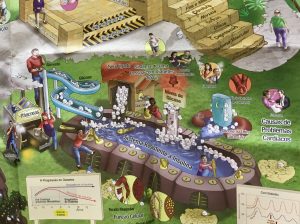Our first day at the hospital was a fast paced, information packed tour of several facilities. It was a day figuring out which shoes to wear, how to pace ourselves on the strong Brazilian coffee (which is everywhere), and meeting more friendly faces than I could count. Days 2 and 3 have felt more grounded. My Portuguese is improving, and I am feeling more familiar with the hospital. These days have been comprised of meetings with different physicians to discuss potential projects for the time we are here. Many of the projects are too complicated to complete in seven weeks, but they arise from fascinating problems, and I will refer them to Rice 360˚.
My Projects
Educational materials for low literacy patients emphasizing cardiovascular health.
This will be based on educational materials that already exist for diabetes, including a model of a foot impacted by diabetes developed by Rice 360˚ and a poster of a park scene that illustrates different aspects of diabetes (a scene from the poster is shown below, detailing factors that can worsen one’s diabetes). I will choose one personal project, and I suspect this will be it, but the decision is not final. I am excited about the opportunities it provides to be creative and to make contributions in disease prevention.
A psychological project working towards relaxing patients during mammograms for clearer scans.
Dr. Micki Hebl from Rice proposed this project at the Barretos Hackathon. Hospital de Amor already uses images and sounds from nature to soothe patients receiving mammograms, and this project would compare the effects this has on the clarity of the patient’s images when viewing static nature, mobile nature, a city or abstract art, and a black screen. There is already evidence that supports using nature to relax hospital patients, but this project is specifically meant to investigate how having a choice regarding the image can improve the mammogram.
Project for Our Barretos Team
Educational materials for Barretos medical students to improve presentation skills.
Dr. Tracy Voltz teaches students how to improve presentations and posters at Rice. Whitney and I each have attended classes with her, and Dr. Matias Melendez has asked us to communicate what we have learned to his students. This could include presenting some useful tips, hosting a peer review workshop, and creating a miniature curriculum for Dr. Melendez to keep after we leave.
Projects for Rice 360˚
Many of these projects involve developing apps or websites. When I return to Houston, I will recommend that Rice 360˚ recruits students interested in healthcare who are also obtaining Computer Science degrees. I believe such students would be very welcome in Barretos if interns are received here next summer.
A tablet app that allows doctors to organize patient information collected during the rounds.
Vitals, symptoms, and other patient information are stored on paper spreadsheets. These papers are often lost between shifts, and the spreadsheets are not uniform. WiFi and internet are also not reliable for tablet synchronization. Dr. Ricardo dos Reis imagines a tablet app used by the doctors and nurses to record patient information on the rounds. The app will include imaging results as well as the spreadsheet information. There will be multiple tablets, and they need to be synchronized without internet.
A website that simplifies the process for estimating expected remaining lifespan of a patient.
Dr. Carlos Paiva has developed a nomogram to predict probabilities of a patient living for various periods (30 days, 2 months, 6 months, etc). A website also exists that uses a similar algorithm, but it was developed for American patients. Because of differences between the overall health of the Brazilian patients and the American patients, this website’s algorithm cannot be used for Dr. Paiva’s patients. Dr. Paiva’s paper nomogram is difficult to read by the untrained eye, and can lead to inaccurate estimates.
For Dr. Paiva’s nomogram: https://onlinelibrary.wiley.com/doi/full/10.1002/cam4.1582
For the website: https://www.predictsurvival.com/
A game that encourages children to stay still while receiving radiotherapy.
Young children receiving daily radiotherapy are prone to movement, sometimes even attempting to climb from the radiotherapy table, which can be raised very high during treatment. As a result, the children are often anesthetized for treatment. Radiotherapy requires multiple sessions, so children are put under anesthesia every day for a month in some cases. To avoid anesthesia, Dr. Daniel Marconi and Dr. Lucas Guimarães suggest a game or visual that encourages children to remain still.
A similar stimulus is needed to control patient breathing when receiving radiotherapy for cancers that move with the breath.
An affordable, customizable material that improves radiation contact with the skin during radiotherapy for patients with skin cancer.
Skin cancer is very common in Brazil. Farming is culturally widespread, and sun protection is not. When patients receive radiotherapy for other cancers, the radiation must pass through the skin to target the underlying cancer. When doctors intend to target the skin, a layer of material must be placed over the skin so that the radiation first penetrates the initial layers and accesses the correct point. For irregular planes of the body, for example the nose, it can be very difficult to target the correct later with the intended radiation strength. Customized masks with material as dense as skin exist for this purpose in the states, but they cost a few thousand US dollars per patient. These costs are not realistic in Brazil. The doctors here are interested in 3D printing the masks from precise scans of the patient’s face.

